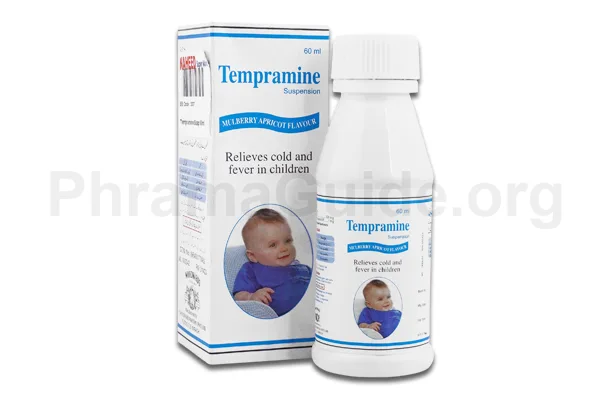Tempramine syrup is a medication that is used for the relief of symptoms associated with various allergic conditions and mild to moderate pain or fever. It is a combination of antipyretic and anti-histamine that is mostly recommended for children and adults where a low dose of medicine is needed. The following are some approved and off-label uses of Tempramine Syrup:
Approved Uses of Tempramin Syrup
- Allergic Rhinitis: Tempramine syrup may be used to relieve symptoms associated with allergic rhinitides, such as sneezing, itching, runny nose, and nasal congestion caused by allergies to substances like pollen, dust mites, or pet dander.
- Common Cold and Flu: The use of Tempramine syrup can help alleviate symptoms associated with the common cold and flu, including fever, headache, body aches, nasal congestion, and sneezing.
- Sinusitis: Tempramine syrup is used in children with sinusitis, which is the inflammation of the sinuses often caused by infection, the syrup can provide relief from symptoms such as facial pain, headache, nasal congestion, and fever.
- Allergic Skin Conditions: In certain cases, Tempramine syrup may be used to help manage symptoms of allergic skin conditions, such as urticaria (hives) or allergic dermatitis, which can involve itching, redness, and inflammation.
Mild to Moderate Pain: Tempramine syrup is also used to relieve pain and fever in children. It can help provide relief from mild to moderate pain, such as headaches, toothaches, and muscle aches. - Fever: Using Tempramine syrup is also effective in reducing fever associated with various conditions, including colds, flu, and other viral or bacterial infections.
Off-label Uses of Tempramine Syrup
- Cough and Cold Relief: Tempramine Syrup may be used off-label to provide symptomatic relief for cough and cold symptoms, such as nasal congestion, runny nose, sneezing, and mild throat irritation.
- Pruritus: Pruritus, or itching, caused by various conditions like allergic reactions, insect bites, or dermatitis, may be managed off-label with Tempramine syrup to alleviate discomfort.

What is Tempramine?
Tempramine Syrup is one of the leading brands with a combination of Chlorpheniramine and Paracetamol, manufactured and marketed by W.Woodward Pakistan (Pvt) Ltd.
Tempramine Alternatives : Other Similar Brands
Below are some available similar syrups that can be used as an alternative to Tempramine:
- Campol Plus : Sytex Pharmaceuticals, Pakistan.
- Pedrol Total : Stanley Pharmaceuticals (Pvt) Ltd, Pakistan.
- Kofnil : The Schazoo Laboratories, Pakistan.
- Chilpol Total : Alliance Pharmaceuticals (Pvt) Ltd, Pakistan.
Tempramine : Available Formulations and Strengths
Presently, Tempramine is available in syrup form.
Each 5ml of Tempramine Syrup Contains:
- Chlorpheniramine: 1mg
- Paracetamol: 120mg
Who Should Not Use Tempramine?
Tempramine syrup has a few contraindications, which are specific situations or conditions in which the use of Tempramine is not recommended due to potential risks.
Allergy or Hypersensitivity: Individuals who have a known allergy or hypersensitivity to chlorpheniramine, paracetamol, or any other ingredients in the syrup should not use Tempramine Syrup.
Severe Liver Disease: Since paracetamol is metabolized by the liver, individuals with severe liver disease or liver failure should avoid using Tempramine syrup. Paracetamol can further stress the liver and potentially cause liver damage.
Glaucoma: Chlorpheniramine, as an antihistamine, can cause an increase in intraocular pressure, which can worsen the symptoms of glaucoma. Therefore, individuals with glaucoma should avoid using Tempramine syrup.
Urinary Retention: Chlorpheniramine can cause urinary retention, making it difficult to pass urine. Individuals with a history of urinary retention or bladder neck obstruction should not use Tempramine syrup.
Prostate Hypertrophy: Chlorpheniramine can exacerbate the symptoms of prostate hypertrophy (enlarged prostate), such as difficulty urinating. Therefore, individuals with prostate hypertrophy should avoid using Tempramine syrup.
Use of MAO inhibitors: Monoamine oxidase (MAO) inhibitors, a class of antidepressant medications, can interact with chlorpheniramine and cause serious side effects. Therefore, the use of Tempramine syrup is contraindicated in individuals taking or who have taken MAO inhibitors within the past 14 days.
Recommended Daily Dosage of Tempramine Syrup
Tempramine Syrup Dose for Adults and Children (12 years and older):
- 10 ml (two teaspoons) of syrup every 4 to 6 hours, up to a maximum of 40 ml (eight teaspoons) in 24 hours.
- It is important to not exceed the recommended daily dose or frequency of administration.
Tempramine Syrup Dose for Children (6 to 12 years):
- 5 ml (one teaspoon) of syrup every 4 to 6 hours, up to a maximum of 20 ml (four teaspoons) in 24 hours.
Tempramine Syrup Dose for Children under 6 years:
- The use of Tempramine syrup in children under 6 years should be based on the guidance and recommendation of a healthcare professional.
- The dose may be adjusted based on the child’s age, weight, and specific needs.
How Tempramine Works?
Tempramine’s mode of action depends on it active ingredients present in syrup.
Each ingredient has its own mode of action:
- Chlorpheniramine: Chlorpheniramine is an antihistamine that works by blocking the effects of histamine, a substance produced by the body during an allergic reaction. Histamine is responsible for triggering allergy symptoms such as itching, sneezing, runny nose, and watery eyes. By blocking histamine receptors, chlorpheniramine helps to alleviate these allergy symptoms.
- Paracetamol (Acetaminophen): Paracetamol is a widely used analgesic (pain reliever) and antipyretic (fever reducer). Its exact mode of action is not fully understood, but it is believed to work by inhibiting the synthesis of certain chemicals called prostaglandins in the central nervous system. Prostaglandins are involved in the perception of pain and the regulation of body temperature. By reducing the production of prostaglandins, paracetamol helps to relieve mild to moderate pain and reduce fever.

Leave A Comment